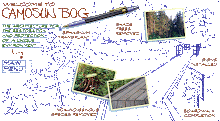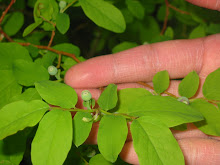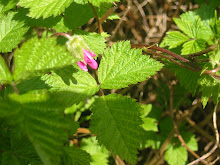Monday, June 28, 2010
Youth Involvement
I hope to post more in the future, but for now I will write briefly on youth involvement.
While I generally do not separate people by age-- the last time I checked such things, I noticed I have friends from age 9 to 85-- I think Camosun bog a is wonderful community (ecological and social) for young people. I see Camosun bog as a safe place where youngsters can learn about nature. Furthermore, youth Crazy Boggers are learning from mentors as well as acting as mentors. I think mentorship can have lifelong positive impacts on those involved, with positive effects on their intellectual and emotional development. The physical exercise for restless youngsters is also an asset of bog restoration; for example, the pulling out of roots and old stumps can get a teenager's endorphins rushing ("happy hormones" at this age are a plus!).
Anyways, while there are many other ways I think the bog benefits young people, I would like to pass the following question over to others:
How do you think being a Camosun Bogger positively impacts the lives of youth?
Thursday, June 17, 2010
Tree Frogs vs Bullfrogs
Tree frogs are very small – 2-4cm long. They come in two colour phases – either brown with dark blotches or bright green. They always have a black stripe running from their nose past the eye and down to the shoulder. They make a “ricket-ricket” sound way out of proportion to their size http://www.naturesongs.com/frog3.wav
Bullfrogs make a quite different sound, rather like a rapidly repeating foghorn http://www.learnnc.org/lp/media/collections/fieldguide/frogcalls/bullfrog.mp3 They are far bigger than tree frogs – up to 25cm and can weigh up to 2kg.. They expand like balloons when attacked and have teeth on their lower jaw to hold their prey. They eat almost anything. They were introduced from Africa and are a thoroughly nasty species in this area.
A Frog in the Bog
One major reason for the loss of tree frogs has been bullfrogs. These were introduced to this area in the 1930s to produce frog legs for French restaurants. They didn’t catch on and were released in the Langley area. They have almost no predators – possibly herons – and each female produces 20,000 eggs every year. They can travel 1½ km in an evening and jump 2m high. There are reports of them eating cats! (see http://www.barbelith.com/topic/2486)
They arrived in Camosun Bog 7-8 years ago and very quickly eliminated the remaining tree frogs. Having eaten them all, the bullfrogs then moved on to happier hunting grounds.
Over the last couple of years, the tree frogs have started to move back into the bog. This may be due to us expanding and deepening the pond and particularly this year it may have been helped by the very wet spring we have had. At one work party in April we were deafened by their sound and had to shout to be heard. The inevitable male-female thing happened and now we have lots of tadpoles swimming around in the pond!
Let’s hope the tree frog population continues to increase. It is essential that we do not disturb the tadpoles and we must not allow anybody to collect them. There is a real danger that the sound of the peepers will attract the bullfrogs and they will return to wipe out the population again. Unfortunately there is not much we can do to stop this. We tried to catch them some years ago but we were never successful as they disappear as soon as someone approaches them. Probably we will get into a long-term cycle of gradually increasing population followed by a crash. Rather similar to the lemming – snowy owl cycle in the arctic. We will see…..
Tuesday, June 15, 2010
A Poem for the Bog
Greetings fellow crazy Camosun bloggers!
The following is a short piece I composed for my creative writing course. We were asked to compose a poem on a moment in nature. I chose to write mine about the precariously leaning tree that had been damaged by the big storm we had earlier this spring.
Log
Acrobatic droplets slice like liquid silver razor blades.
Wind whips from the west, wet and wild off the water.
Gravity is a suckling leech, resistance ferments in its belly.
Weather is a pitbull: teeth gnashing, tether snapped.
Trunk exhales like a bullfrog being flattened under workboots.
Lacking leaves, this living log leans and lists lower.
Bark is corrugated cardboard, clapboard for a slovenly hovel.
Pestilence the only resident: a squatting vandal.
Taut roots snap with a pungent puff of rancid apples.
A dank drape of detritus and decay: the dark, dense dirt.
Roots are worms, living carcasses embedded in the soil.
Robins pluck them one by one with a rusty pair of chopsticks.
The workman's hands are smooth as encrusted barnacles.
His choking chainsaw chews: chipping, chopping, chiseling.
Metallic teeth hyaenas snorting and chortling about their kill.
But they forfeit their slaughter, a feast for scavenging locals.
Tuesday, June 8, 2010
Time travel to bogs, fens, flats, by inchmeal - how deep is Camosun Bog?
Saturday, June 5, 2010
Birth of a Sundew
"Sundews have tiny cylindrical seeds, with a diameter not much greater than a human hair. The photo shows the seed on the right, with the shoot coming out near the end and splitting into three tiny leaves. Neat!"
--emailed to me from Laurence Brown
Friday, June 4, 2010
Bog Preservation, literally
"We die containing a richness of lovers and tribes, tastes we have swallowed, bodies we have plunged into and swum up as if rivers of wisdom, characters we have climbed into as if trees, fears we have hidden in as if caves. I wish for all this to be marked on by body when I am dead. I believe in such cartography - to be marked by nature, not just to label ourselves on a map like the names of rich men and women on buildings. We are communal histories, communal books."
Michael Ondaatje, The English PatientBrothers Emil and Viggo discovered a body in their bog and called the police. The police examined the clothing on the body and phoned the museum...
What is a bog and how is it able to preserve things for so long? Find out here
Nova's interactive on Tollund Man
The Crazy Boggers also found some artifacts, though no body has turned up...yet.
Thursday, June 3, 2010
Storytelling and getting dirty
Place Based Education and Complexity
Blueberry or Huckleberry?













